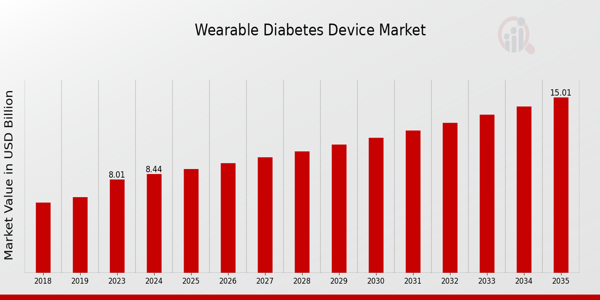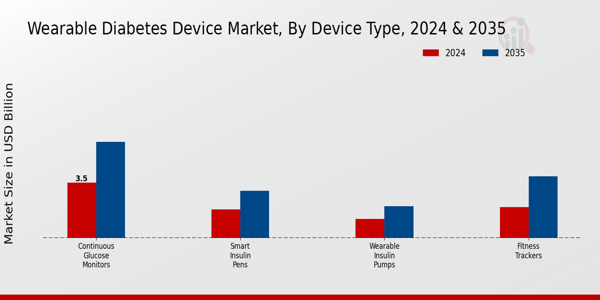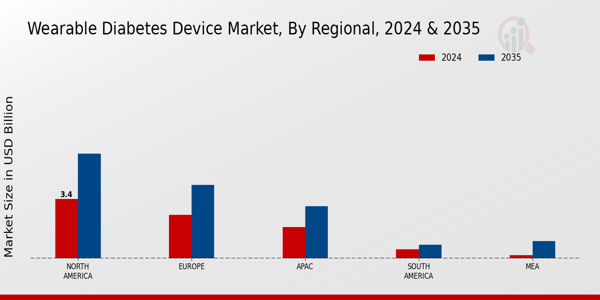Global Wearable Diabetes Device Market Overview
As per MRFR analysis, the Wearable Diabetes Device Market Size was estimated at 8.01 (USD Billion) in 2023.
The Wearable Diabetes Device Market Industry is expected to grow from 8.44(USD Billion) in 2024 to 15.0 (USD Billion) by 2035. The Wearable Diabetes Device Market CAGR (growth rate) is expected to be around 5.37% during the forecast period (2025 - 2035).
Key Wearable Diabetes Device Market Trends Highlighted
The global wearable diabetes device market is experiencing significant growth driven by the increasing prevalence of diabetes and the rising demand for continuous glucose monitoring solutions. Innovations in technology, such as the development of non-invasive sensors and smart wearable devices, are enhancing patient convenience and adherence to diabetes management. Additionally, the demand for real-time data and remote patient monitoring is encouraging healthcare providers to adopt wearable devices. As the healthcare landscape shifts towards personalized medicine, these devices are offering users tailored management strategies that improve health outcomes.There are numerous opportunities to be explored within this market, particularly in the enhancement of user engagement and the integration of artificial intelligence in diabetes management applications. Companies are increasingly focusing on developing devices that not only monitor glucose levels but also provide actionable insights through predictive analytics. There is potential for collaboration with technology firms to create integrated platforms that enhance user experience. Furthermore, expanding into emerging markets where diabetes prevalence is rising can present untapped customer bases for wearable diabetes devices. In recent times, the trend has been towards incorporating advanced features such as direct connectivity to smartphones and cloud-based data storage, allowing for seamless data sharing between patients and healthcare providers.The integration of fitness tracking with diabetes management is also gaining traction as users seek holistic approaches to their health. Additionally, the emphasis on user-friendly designs that encourage daily wear is reshaping product development. As the market evolves, a stronger focus on customization and lifestyle integration is becoming essential, catering to the unique needs and preferences of individuals living with diabetes. Such trends indicate a dynamic and rapidly advancing sector poised for future innovations.

Source: Primary Research, Secondary Research, MRFR Database and Analyst Review
Wearable Diabetes Device Market Drivers
Rising Prevalence of Diabetes
The increasing prevalence of diabetes globally is one of the foremost drivers boosting the Global Wearable Diabetes Device Market Industry. The World Health Organization has reported a significant rise in diabetes cases over the years due to factors such as sedentary lifestyles, unhealthy diets, and obesity, which are becoming increasingly common. Wearable diabetes devices, designed to monitor blood glucose levels and offer real-time health insights, are becoming imperative for managing diabetes effectively.The urgent need for continuous monitoring to prevent complications has driven the demand for these devices. Consequently, innovative wearable technologies that offer features like seamless integration with smartphones and user-friendly interfaces have emerged, making it easier for patients to track their health. This trend is further fueled by the shift toward personalized healthcare, where patients actively engage in the management of their own conditions.Moreover, healthcare professionals are also advocating the use of such devices for better diabetes management outcomes. As the Global Wearable Diabetes Device Market continues to grow, it signifies a shift in the approach toward diabetes care, transitioning from merely treating the disease to proactive management through technology. Individuals are becoming increasingly health-conscious, leading to a surge in the demand for devices that provide a better quality of life, improve health outcomes, and reduce healthcare costs associated with diabetes complications.
Technological Advancements in Wearable Devices
Technological innovations in wearable devices are significantly propelling the Global Wearable Diabetes Device Market Industry forward. Advances such as continuous glucose monitoring (CGM) systems, which allow individuals to track their glucose levels in real-time, are making diabetes management more efficient and less intrusive. These devices often come equipped with features like alerts for high or low blood sugar levels and integration with mobile applications, enabling users to analyze their data comprehensively.As technology evolves, we can expect even more sophisticated devices that will enhance user experience and satisfaction.
Growing Awareness and Adoption of Preventive Healthcare
The growing awareness regarding preventive healthcare is another significant driver of the Global Wearable Diabetes Device Market Industry. As more individuals understand the importance of early detection and management of health conditions, there is an increased tendency to invest in wearable devices. Furthermore, healthcare providers and insurers are more inclined to support these technologies due to their potential to reduce long-term healthcare costs.This growing mindset towards proactive health management will likely support market growth in the coming years.
Wearable Diabetes Device Market Segment Insights
Wearable Diabetes Device Market Device Type Insights
The Global Wearable Diabetes Device Market exhibits a varied landscape when analyzed by Device Type, showcasing significant growth and innovation across its segments. In 2024, the market reflects substantial values, with Continuous Glucose Monitors leading the way at 3.5 USD Billion, illustrating their critical role in diabetes management by providing real-time data that empowers patients to make timely decisions about their treatment. This segment is projected to grow to 6.1 USD Billion by 2035, underscoring its dominance and the increased reliance on continuous monitoring technologies among diabetic individuals. Following closely, Smart Insulin Pens are building their presence, starting at 1.8 USD Billion in 2024 and expected to rise to 3.0 USD Billion in 2035. This growth highlights the practical necessity of these devices in simplifying insulin dosing, thereby easing the treatment burden for patients.
Further down the line, Wearable Insulin Pumps have a valuation of 1.2 USD Billion in 2024, which is projected to increase to 2.0 USD Billion by 2035. While this segment currently holds a smaller share in contrast to Continuous Glucose Monitors, its importance in offering automated insulin delivery algorithms cannot be understated, thereby adding another layer of convenience for users. Fitness Trackers also significantly contribute to the market, starting at 1.94 USD Billion in 2024 and anticipated to reach 3.9 USD Billion by 2035. These devices play a dual role monitoring physical activity while also integrating health metrics, including glucose levels, thus promoting an engaged lifestyle for diabetics.
As the market expands, trends emphasizing personalized healthcare, advancements in technology, and growing awareness about diabetes management are driving forces behind these figures. Challenges remain, including regulatory hurdles and the need for consumer education, yet the opportunities are ample, especially as healthcare continues to trend toward digitization. The Global Wearable Diabetes Device Market segmentation clearly reflects diversified growth across its device types, portraying a collective commitment to better diabetes management solutions. Overall, the segment's valuation illustrates a robust trend towards innovation and adaptation in diabetes care technologies, aligning with the evolving needs of patients and healthcare systems globally.

Source: Primary Research, Secondary Research, MRFR Database and Analyst Review
Wearable Diabetes Device Market Technology Insights
The market shows promising growth driven by advancements in wearables that enhance patient monitoring and health management. The technology segment comprises various connection options, among which Bluetooth is particularly significant due to its widespread adoption and ability to facilitate seamless data transfer between devices. NFC technology is also gaining traction as it offers convenient and quick access to health data, making it user-friendly for patients.Meanwhile, RFID continues to play a vital role in tracking devices and ensuring compliance diabetes treatment regimens. Overall, the advancement of these technologies supports the Global Wearable Diabetes Device Market industry by improving user experience, data accuracy, and overall health outcomes. The increasing inclination towards smart health devices and the pressing need for effective diabetes management solutions are key trends influencing the market growth. These factors, coupled with ongoing innovations, are expected to enhance the Global Wearable Diabetes Device Market statistics over the coming years.
Wearable Diabetes Device Market End User Insights
The Global Wearable Diabetes Device Market is expanding significantly, Adults represent a crucial part of the market due to the rising prevalence of diabetes and their active lifestyle needs, making them key consumers of wearable devices. Pediatric users are also increasingly noteworthy, highlighting the importance of early intervention in diabetes management, while the Geriatric segment is rapidly growing, reflecting the aging population's rising need for efficient diabetes monitoring solutions.As the Global Wearable Diabetes Device Market continues to grow, factors like technological advancements, increased health awareness, and the rising incidence of diabetes are contributing to the market's dynamics. This market segment benefits from tailored devices that cater specifically to the demands of each user group, enhancing user compliance and treatment adherence. The Global Wearable Diabetes Device Market statistics indicate a robust trajectory, with emerging innovations further propelling market growth and responding to unique demographic needs efficiently.
Wearable Diabetes Device Market Distribution Channel Insights
The landscape is dominated by various channels, including Online Stores, Pharmacies, and Retail Stores, each contributing uniquely to accessibility and consumer engagement. Online Stores have gained traction due to the convenience of shopping and the increasing reliance on e-commerce, appealing particularly to tech-savvy consumers. Pharmacies are crucial as they provide a trusted environment for patients, offering personalized consultations alongside product availability, usually leading to a better understanding of diabetes management devices.Retail Stores also hold a significant position by allowing customers to experience the devices firsthand before purchasing, which enhances buyer confidence. The ongoing market growth is driven by the rising diabetic population and advances in wearable technology, with each distribution channel adapting to meet the specific needs of different consumer demographics. Overall, the Global Wearable Diabetes Device Market segmentation into these channels reflects diverse strategies tailored to enhance product reach and satisfy customer preferences.
Wearable Diabetes Device Market Regional Insights
North America holds a majority position with a market valuation of 3.4 USD Billion in 2024, expected to grow to 6.0 USD Billion by 2035, driven by advanced healthcare systems and a high prevalence of diabetes. Europe follows closely, valued at 2.5 USD Billion in 2024 and projected to rise to 4.2 USD Billion, reflecting strong healthcare infrastructure and awareness. The APAC region, valued at 1.8 USD Billion in 2024, will see growth trends leading to 3.0 USD Billion by 2035, fueled by increasing health initiatives and technological advancements.South America and MEA, valued at 0.54 USD Billion and 0.2 USD Billion respectively in 2024, indicate slower growth but present opportunities due to rising diabetes caseswith MEA expected to experience significant strides to reach 1.0 USD Billion by 2035. Overall, the Global Wearable Diabetes Device Market segmentation reveals notable trends and growth drivers in these regions, underscoring the growing demand for innovative diabetes management solutions.

Source: Primary Research, Secondary Research, MRFR Database and Analyst Review
Wearable Diabetes Device Market Key Players and Competitive Insights
The Global Wearable Diabetes Device Market has been experiencing significant growth as advancements in technology have led to more efficient and user-friendly solutions for diabetes management. With the increasing prevalence of diabetes worldwide, there has been a rising demand for innovative devices that can monitor glucose levels in real-time, thereby improving patient outcomes. Companies in this market are investing heavily in research and development to create cutting-edge technologies that cater to the needs of diabetic patients. The competitive landscape is characterized by a diverse range of players, each striving to offer unique features and functionalities that differentiate their products. This has led to an environment where continuous innovation and strategic partnerships are critical for gaining a competitive edge.Abbott Laboratories has established a strong presence in the Global Wearable Diabetes Device Market, primarily recognized for its Freestyle Libre system, which revolutionized glucose monitoring by eliminating the need for routine finger-prick tests. The company's innovative technology allows patients to keep track of their glucose levels continuously, providing real-time data that can be shared with healthcare providers. Abbott Laboratories' commitment to quality and reliability reinforces its reputation among diabetes patients and healthcare professionals alike. By focusing on user experience and ease of use, Abbott Laboratories has successfully positioned itself as a leader in the wearable diabetes device segment, capitalizing on its extensive market reach and strong brand loyalty.Ascensia Diabetes Care has carved out a noteworthy position in the Global Wearable Diabetes Device Market with its expertise in blood glucose monitoring solutions. The company offers a range of advanced glucose monitoring products that emphasize accuracy and convenience, helping users effectively manage their condition. Ascensia is known for its Eversense Continuous Glucose Monitoring system, which stands out for its long-term sensor insertion, allowing patients to obtain near real-time glucose readings for extended periods without frequent replacements. This unique proposition addresses the needs of patients seeking both reliability and convenience in their diabetes management. Ascensia Diabetes Care is also proactive in fostering engagements with diabetes communities, emphasizing education and support for users, further enhancing its competitive advantage in this evolving market.
Key Companies in the Wearable Diabetes Device Market Include
- Abbott Laboratories
- Ascensia Diabetes Care
- Acon Labs
- Roche
- GlucoMe
- DarioHealth
- Tandem Diabetes Care
- Dexcom
- Glucose Monitoring Solutions
- LifeScan
- Nemaura Medical
- Insulet Corporation
- Senseonics
- Medtronic
Wearable Diabetes Device Market Industry Developments
Recent developments in the Global Wearable Diabetes Device Market have shown significant advances in technology and product offerings. Companies like Abbott Laboratories and Dexcom continue to innovate, with Abbott focusing on expanding the capabilities of its FreeStyle Libre system, enhancing real-time glucose monitoring. Medtronic is actively engaging in partnerships to expand their digital health ecosystem, while Tandem Diabetes Care has announced updates to their insulin delivery systems, integrating with mobile applications for improved patient management.
There has also been notable activity regarding mergers and acquisitions, such as Acon Labs exploring opportunities to enhance its product line through strategic alliances, positioning itself within a competitive landscape. Glucomet and Senseonics are also making strides in market expansion, with increasing investments to bolster research and development. This vigorous competition and technological innovation lead to notable market valuation growth, positively impacting investment and consumer interest in wearable diabetes management solutions. Companies are focusing on improving user experience and integrating more sophisticated data analytics to empower patients and streamline diabetes management, shaping the future directions of this flourishing market.
Wearable Diabetes Device Market Segmentation Insights
-
Wearable Diabetes Device Market Device Type Outlook
- Continuous Glucose Monitors
- Smart Insulin Pens
- Wearable Insulin Pumps
- Fitness Trackers
-
Wearable Diabetes Device Market Technology Outlook
-
Wearable Diabetes Device Market End User Outlook
- Adults
- Pediatric
- Geriatric
-
Wearable Diabetes Device Market Distribution Channel Outlook
- Online Stores
- Pharmacies
- Retail Stores
-
Wearable Diabetes Device Market Regional Outlook
- North America
- Europe
- South America
- Asia Pacific
- Middle East and Africa
|
Report Attribute/Metric
|
Details
|
|
Market Size 2023
|
8.01(USD Billion)
|
|
Market Size 2024
|
8.44(USD Billion)
|
|
Market Size 2035
|
15.0(USD Billion)
|
|
Compound Annual Growth Rate (CAGR)
|
5.37% (2025 - 2035)
|
|
Report Coverage
|
Revenue Forecast, Competitive Landscape, Growth Factors, and Trends
|
|
Base Year
|
2024
|
|
Market Forecast Period
|
2025 - 2035
|
|
Historical Data
|
2019 - 2024
|
|
Market Forecast Units
|
USD Billion
|
|
Key Companies Profiled
|
Abbott Laboratories, Ascensia Diabetes Care, Acon Labs, Roche, GlucoMe, DarioHealth, Tandem Diabetes Care, Dexcom, Glucose Monitoring Solutions, LifeScan, Nemaura Medical, Insulet Corporation, Senseonics, Medtronic
|
|
Segments Covered
|
Device Type, Technology, End User, Distribution Channel, Regional
|
|
Key Market Opportunities
|
1. Remote patient monitoring solutions,
2. Integration with mobile health apps,
3. Advanced glucose monitoring technologies,
4. Increased awareness of diabetes management,
5. Rising aging population with diabetes
|
|
Key Market Dynamics
|
1. Technological advancements in devices,
2. Increasing prevalence of diabetes,
3. Growing health awareness among consumers,
4. Demand for remote patient monitoring,
5. Rising adoption of telehealth solutions
|
|
Countries Covered
|
North America, Europe, APAC, South America, MEA
|
Frequently Asked Questions (FAQ) :
The Wearable Diabetes Device Market is expected to be valued at 8.44 USD Billion in 2024.
By 2035, the market is projected to reach a value of 15.0 USD Billion.
The expected CAGR for this market from 2025 to 2035 is 5.37%.
North America is anticipated to be the dominant region, with a market value of 6.0 USD Billion by 2035.
The market value for Continuous Glucose Monitors is expected to be 3.5 USD Billion in 2024.
Key players include Abbott Laboratories, Roche, Dexcom, and Medtronic, among others.
Smart Insulin Pens are expected to reach a market value of 3.0 USD Billion by 2035.
The market for the APAC region is projected to grow to 3.0 USD Billion by 2035.
The market value for Wearable Insulin Pumps is expected to be 1.2 USD Billion in 2024.
Key growth drivers include increasing diabetes prevalence and technological advancements in wearable devices.

















